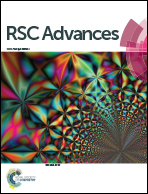An expedient route to highly diversified [1,2,3]triazolo[1,5-a][1,4]benzodiazepines and their evaluation for antimicrobial, antiproliferative and in silico studies†
Abstract
An efficient diversity oriented synthesis of [1,2,3]triazolo[1,5-a][1,4]benzodiazepines has been developed by sequential diazotization, azidation and cycloaddition reactions in a one-pot fashion. This strategy allows an easy accessibility of triazole fused [1,4]benzodiazepines in good yields. The main objective of this methodology is to introduce various substituents at all possible positions under mild reaction conditions. All the synthesized compounds were evaluated for their antimicrobial, anticancer and in silico activity. Among the tested compounds (2a–n), the derivatives 2a, 2b, 2d, 2k, 2g, 2j, 2m and 2l have displayed a broad spectrum of antibacterial activity. Anticancer activity results revealed that compounds 2a, 2g and 2m exhibited potent in vitro anticancer activity against A549 lung adenocarcinoma cancer cell line. Further, molecular docking studies of all the synthesized compounds were performed to gain a comprehensive understanding of the plausible binding modes and also to compare the theoretical and experimental results of these compounds.
![Graphical abstract: An expedient route to highly diversified [1,2,3]triazolo[1,5-a][1,4]benzodiazepines and their evaluation for antimicrobial, antiproliferative and in silico studies](/en/Image/Get?imageInfo.ImageType=GA&imageInfo.ImageIdentifier.ManuscriptID=C5RA12497B&imageInfo.ImageIdentifier.Year=2015)

 Please wait while we load your content...
Please wait while we load your content...